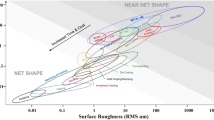Abstract
Three-dimensional (3D) additive manufacturing technologies are useful for building various and complicated shapes. Representative technologies include laser metal deposition and selective laser sintering that make metal powders melt in order to form diverse 3D structures. Although numerous well-known advantages of 3D additive manufacturing, they still have some difficulties in surface quality improvement for further applications such as food or biomedical industries because they cause rough surfaces, discoloration, unmelted particles by repeated instant dissolution and solidification of metal particles. This paper introduces an electrochemical polishing (or electropolishing, ECP) process as a possible finishing process for 3D printed parts. Conventional finishing processes including mechanical finishing can hardly polish 3D curved surface readily. In ECP, the tool electrode and the work sample are not in contact with each other. All electrically connected surface exposed to electrolyte are subject to be polished. The printed product performs in a current density region higher than the conventional current density, thereby activating the electrochemical reaction and promoting the dissolution of the metal surface, thereby smoothly polishing a very rough surface. Surface quality including roughness, splashed particle spots, smoothness, brightness, light reflection and corrosion resistance were improved by ECP. Experimental results were analyzed by scanning electron microscopy, optical and detailed atomic force microscopy images according to various ECP electrical conditions.












Similar content being viewed by others
References
Ko, H., Moon, S. K., & Hwang, J. (2015). Design for additive manufacturing in customized products. International Journal of Precision Engineering and Manufacturing, 16(11), 2369–2375.
Chua, Z. Y., Ahn, I. H., & Moon, S. K. (2017). Process monitoring and inspection systems in metal additive manufacturing: Status and applications. International Journal of Precision Engineering and Manufacturing-Green Technology, 4(2), 235–245.
Lee, J., Kim, H. C., Choi, J. W., & Lee, I. H. (2017). A review on 3D printed smart devices for 4D printing. International Journal of Precision Engineering and Manufacturing-Green Technology, 4(3), 373–383.
Zhang, K., Liu, W., & Shang, X. (2007). Research on the processing experiments of laser metal deposition shaping. Optics & Laser Technology, 39(3), 549–557.
Hong, C., Gu, D., Dai, D., Gasser, A., Weisheit, A., Kelbassa, I., et al. (2013). Laser metal deposition of TiC/Inconel 718 composites with tailored interfacial microstructures. Optics & Laser Technology, 54, 98–109.
Khademzadeh, S., Parvin, N., & Bariani, P. F. (2015). Production of NiTi alloy by direct metal deposition of mechanically alloyed powder mixtures. International Journal of Precision Engineering and Manufacturing, 16(11), 2333–2338.
Agarwala, M., Bourell, D., Beaman, J., Marcus, H., & Barlow, J. (1995). Direct selective laser sintering of metals. Rapid Prototyping Journal, 1(1), 26–36.
Das, S. (2003). Physical aspects of process control in selective laser sintering of metals. Advanced Engineering Materials, 5(10), 701–711.
Lee, H., Lim, C. H. J., Low, M. J., Tham, N., Murukeshan, V. M., & Kim, Y. J. (2017). Lasers in additive manufacturing: A review. International Journal of Precision Engineering and Manufacturing-Green Technology, 4(3), 307–322.
Nowotny, S., Scharek, S., Beyer, E., & Richter, K. H. (2007). Laser beam build-up welding: Precision in repair, surface cladding, and direct 3D metal deposition. Journal of Thermal Spray Technology, 16(3), 344–348.
Chua, Z. Y., Ahn, I. H., & Moon, S. K. (2017). Process monitoring and inspection systems in metal additive manufacturing: Status and applications. International Journal of Precision Engineering and Manufacturing-Green Technology, 4(2), 235–245.
Park, J. W., & Lee, D. W. (2009). Pulse electrochemical polishing for microrecesses based on a coulostatic analysis. The International Journal of Advanced Manufacturing Technology, 40(7–8), 742–748.
Habibzadeh, S., Li, L., Shum-Tim, D., Davis, E. C., & Omanovic, S. (2014). Electrochemical polishing as a 316L stainless steel surface treatment method: Towards the improvement of biocompatibility. Corrosion Science, 87, 89–100.
Gomez-Gallegos, A. A., Mill, F., & Mount, A. R. (2016). Surface finish control by electrochemical polishing in stainless steel 316 pipes. Journal of Manufacturing Processes, 23, 83–89.
Baicheng, Z., Xiaohua, L., Jiaming, B., Junfeng, G., Pan, W., Chen-nan, S., et al. (2017). Study of selective laser melting (SLM) Inconel 718 part surface improvement by electrochemical polishing. Materials and Design, 116, 531–537.
Kim, Y. B., Jeong, S. H., & Park, J. W. (2013). Adsorption characteristics of micro algae on surface-modified photobioreactor system. Journal of Biobased Materials and Bioenergy, 7(1), 80–84.
Kim, Y. B., & Park, J. W. (2012). Effect of pulse time on surface characteristics and corrosion resistance during pulse electrochemical polishing. Transactions of the Nonferrous Metals Society of China, 22, s876–s880.
Rokosz, K., Lahtinen, J., Hryniewicz, T., & Rzadkiewicz, S. (2015). XPS depth profiling analysis of passive surface layers formed on austenitic AISI 304L and AISI 316L SS after high-current-density electropolishing. Surface and Coatings Technology, 276, 516–520.
Acknowledgements
This research was partially supported by research fund from Chosun University 2017 and Basic Science Research Program through the National Research Foundation of Korea (NRF) funded by the Ministry of Education (NRF-2017R1D1A1B03031463).
Author information
Authors and Affiliations
Corresponding author
Additional information
Publisher's Note
Springer Nature remains neutral with regard to jurisdictional claims in published maps and institutional affiliations.
Rights and permissions
About this article
Cite this article
Kim, U.S., Park, J.W. High-Quality Surface Finishing of Industrial Three-Dimensional Metal Additive Manufacturing Using Electrochemical Polishing. Int. J. of Precis. Eng. and Manuf.-Green Tech. 6, 11–21 (2019). https://doi.org/10.1007/s40684-019-00019-2
Received:
Revised:
Accepted:
Published:
Issue Date:
DOI: https://doi.org/10.1007/s40684-019-00019-2




